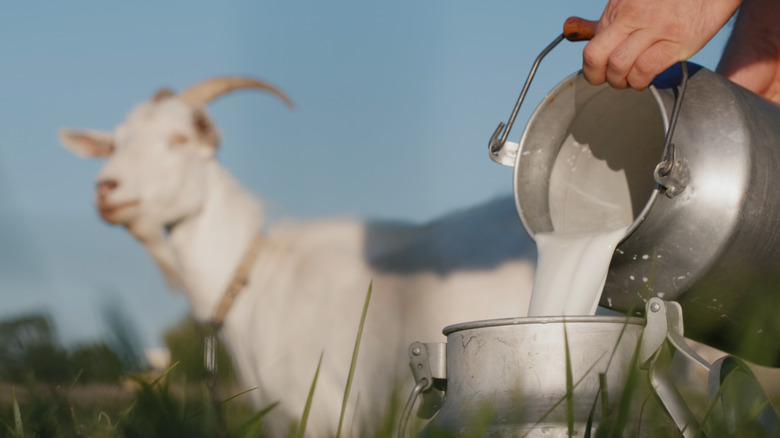The Reason Goat Milk Is More Expensive Than Cows'
The word "milk" usually brings to mind cows' milk. Of course, that's far from the only kind. Some of the most common milk products come from goats, sheep, and water buffalo (via Cypress Grove). Of those, goats' milk is perhaps the most well-known, second only to the ubiquitous cows' milk. And it's not just a beverage; it can be used to make other dairy items, like cheese or goat's-milk ice cream.
There are many differences between cows' milk and goats' milk. Per Foodiosity, goat milk has a muskier, alkaline flavor, and a smell to match. Goat milk also has smaller butterfat molecules, meaning the liquid is less likely to separate (cows' milk is typically homogenized to account for this). On the whole, it's also somewhat fattier than cows' milk. Similarly, goat cheese tends to be more bitter and piquant than that of cows, according to Cook's Info. Chèvre, French for goat cheese, is creamy, and often sold in small cylinders coated with ash, herbs, or pepper. Despite these minor compositional differences, the two milk products are pretty similar and can often work as replacements for one another.
Yet, the main difference you'll notice at the store is the price between the two types. Got Milk? claims goats' milk is almost five times as expensive as cows' milk, but why is this?
Supply and demand
There are several reasons goats' milk is, on average, more expensive than cows', but it mostly comes down to how much product there is and how many people want it — plus the costs involved in bridging the two (via Cypress Grove). There are millions of milk cows in the U.S., but as of 2020, there were only 450,000 milk goats (via USDA). Add to that the fact that goats are many times less productive when it comes to milk (goats don't even lactate all year, per Cook's Info), resulting in low supply. Despite this, demand has been growing lately, according to Dairyreporter.com. Further increasing demand is the fact that some goat milk is being used in hygiene products, according to Foodiosity. This low supply and high demand mean that producers can charge more.
As explained by Cypress Grove, the price of milk products can also depend on production scale, the techniques involved, and transportation costs. Beyond that, the production of goat milk can be more intensive. Goat farms are relatively small, so there's less opportunity to multiply efficiencies into considerable cost savings. Also, since some goat cheese is aged for longer, the labor and storage costs are increased. A lot of the time, the finished product has farther to travel because there are fewer goat milk farms. These costs get passed on to the consumers. So, rest assured: While goat milk and its products may seem pricey, you're not getting gouged.

